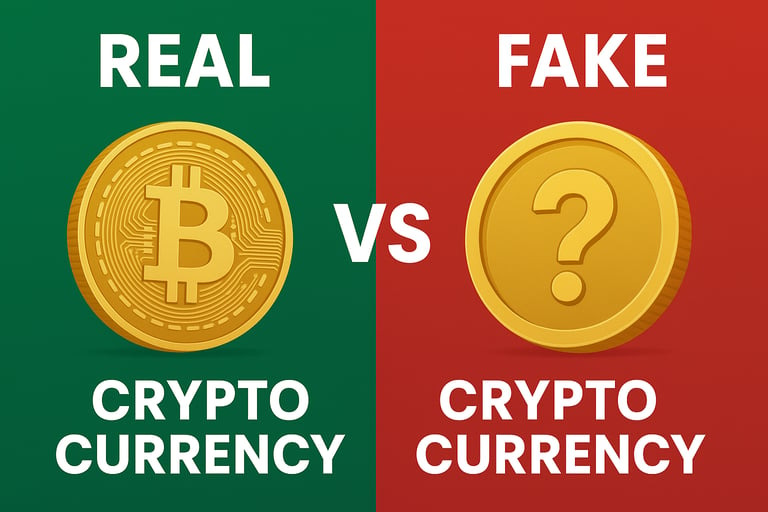How to Spot Fake vs Real Cryptocurrency in 2026 – Complete DropFinder Guide
Fake cryptocurrencies and scam tokens are flooding the market in 2026. Learn how to identify real vs fake crypto projects using this complete DropFinder guide — with practical tips, red flags, and expert insights to protect your investments.
LATEST AIRDROPICOCRYPTO NEWS
10/4/20256 min read
💡 How to Spot Fake vs Real Cryptocurrency in 2026 – Complete DropFinder Guide
🔍 Introduction: The Crypto Scam Epidemic
Cryptocurrency promised a decentralized revolution — a world where you could control your money without banks, borders, or restrictions.
But with freedom came chaos.
By 2026, crypto scams have evolved into one of the most sophisticated forms of online fraud, targeting both beginners and experienced investors. Fake tokens, rug pulls, cloned projects, and pump-and-dump schemes have cost investors billions worldwide.
According to DropFinder’s 2026 Crypto Security Index, over 38% of new crypto tokens launched in 2025–2026 showed signs of being fraudulent or artificially inflated.
So how do you tell a real crypto project from a fake one?
Let’s break it down step-by-step — with examples, expert insights, and reliable detection methods.
💰 What Is a “Fake Cryptocurrency”?
A fake cryptocurrency isn’t just a coin that fails — it’s one that’s built to deceive.
These are projects that mimic legitimate cryptos or create fake hype to steal investor funds.
Common Types of Fake Cryptocurrencies:
Rug Pull Tokens – Tokens launched to pump prices before founders vanish with liquidity.
Ponzi Coins – Offer unrealistic returns (“5x guaranteed profit in 30 days”).
Cloned Coins – Copy legitimate project names, logos, or websites.
Fake Presales or Airdrops – Use marketing buzz to collect investors’ money, then disappear.
Malicious Smart Contracts – Hidden code allows developers to drain liquidity or block sales.
In essence, fake cryptos exist to extract, not to innovate.
🧠 Step 1: Research the Project Team
A real cryptocurrency project has a verifiable, transparent team.
Fake ones often hide behind fake names, AI-generated photos, or unverifiable LinkedIn profiles.
✅ Signs of a Real Team:
Founders and developers are publicly known.
They have previous projects, GitHub contributions, or crypto presence.
Their LinkedIn or Twitter accounts are active and consistent.
They appear in interviews or AMAs (Ask Me Anything sessions).
🚫 Signs of a Fake Team:
No team page on the website.
Stock or AI-generated profile pictures.
Inconsistent online activity or suspiciously new accounts.
“Anonymous dev” excuse without reason.
DropFinder’s 2026 Crypto Scam Audit found that 81% of rug-pull projects had no verifiable founders.
🔍 Step 2: Analyze the Whitepaper
Every serious cryptocurrency has a whitepaper — a document explaining the project’s purpose, technology, and roadmap.
✅ Real Whitepaper:
Clearly explains use-case, tokenomics, and goals.
Written in professional language with detailed technical sections.
Includes credible citations and development roadmap.
🚫 Fake Whitepaper:
Filled with vague promises like “revolutionary blockchain” or “next Bitcoin.”
Plagiarized or poorly formatted.
Avoids technical explanations.
Overemphasizes profits and hype rather than purpose.
📊 Example:
In DropFinder’s “Crypto Red Flag Index (2026),” fake projects like MoonFarmX and MetaVerseVault had whitepapers that were 90% copy-pasted from other sources.
💹 Step 3: Check the Tokenomics
“Tokenomics” means how tokens are distributed, who controls them, and how they gain value.
✅ Real Tokenomics:
Team allocation is reasonable (10–20% max).
Locked liquidity pools for at least 1–3 years.
Transparent vesting schedule for investors and team members.
Real-world use-case driving value (utility, staking, governance, etc.).
🚫 Fake Tokenomics:
Team holds 50–80% of total supply.
No locked liquidity — developers can drain the pool.
No clear purpose or use-case.
Rewards or profits that seem too good to be true.
DropFinder’s Rug Pull Tracker 2026 revealed that 92% of scam tokens had team wallets holding more than 50% of supply — making rug pulls inevitable.
📈 Step 4: Verify Smart Contract on Blockchain
Most tokens are built on public blockchains (Ethereum, BNB Chain, Solana, etc.), so their contracts are visible.
You can use sites like:
Etherscan.io (Ethereum)
BSCScan.com (BNB Chain)
Solscan.io (Solana)
✅ What to Look For:
Contract is verified and open-source.
Ownership is renounced (developer no longer controls it).
Liquidity pool locked on trusted platforms (like PinkSale, Unicrypt, or Team Finance).
🚫 Red Flags:
Contract not verified.
Ownership not renounced (developer can change functions).
“Mint” or “Blacklist” functions hidden in code (allow devs to manipulate wallets).
DropFinder’s DeFi Transparency Report 2026 noted that 78% of fake cryptos had unverified or modifiable smart contracts.
💬 Step 5: Evaluate the Community
A strong, organic community is the backbone of any genuine crypto project.
✅ Real Community Traits:
Members discuss tech updates, not just price.
Moderators address user concerns openly.
Gradual growth — not overnight surges.
🚫 Fake Community Traits:
Thousands of bots spamming “To the Moon!” messages.
Telegram or Discord activity limited to hype and emojis.
No developer interactions or AMA sessions.
Paid shills or influencers promoting it without transparency.
DropFinder’s 2026 Social Audit discovered that 60% of Telegram-based crypto projects had over 50% bot followers.
📢 Step 6: Investigate Marketing and Influencer Activity
Scam tokens often rely on flashy marketing campaigns to trap investors.
🚫 Red Flags:
Paid celebrities or influencers who have no crypto expertise.
Overuse of buzzwords like “next Shiba Inu” or “guaranteed x100.”
Lack of real partnerships (fake “collabs” with Binance, Coinbase, etc.).
“Limited presale” or “launch in 24 hours” urgency traps.
✅ What Real Projects Do:
Focus on development progress and roadmap milestones.
Partner with verified platforms and known investors.
Conduct transparent AMAs and media releases.
DropFinder’s Influencer Risk Index (2026) lists “pump-and-dump marketing” as one of the top three predictors of fake crypto activity.
🧾 Step 7: Check Audit Reports
Audits are formal code reviews by third-party cybersecurity firms.
✅ Trusted Audit Firms:
CertiK
Hacken
SlowMist
PeckShield
Solidity Finance
🚫 Red Flags:
No audit or fake audit certificates.
“Audit coming soon” on websites (stall tactic).
Forged PDF reports or broken verification links.
Real projects proudly link their audit report page on the firm’s official website.
🌐 Step 8: Inspect the Website and Domain
A website says a lot about a project’s legitimacy.
✅ Signs of Authenticity:
HTTPS-secured domain.
Professional design with detailed content.
Contact details, privacy policy, and roadmap.
Social media links leading to real, active accounts.
🚫 Signs of a Scam:
Generic design, poor grammar, or broken links.
Website created recently (check on Whois Lookup).
No contact info or anonymous domain registration.
Fake “Partnership” badges with top exchanges.
DropFinder’s Scam Domain Report 2026 identified that over 70% of fake crypto websites were hosted on cheap domains created less than 30 days before launch.
📊 Step 9: Analyze Price and Trading Volume
Price manipulation is a common trick among scam tokens.
🚫 Suspicious Patterns:
Unrealistic price pumps (1000% in hours).
Trading volume that doesn’t match market cap.
Trades happening only in one exchange or DEX.
Sudden volume spikes followed by flatline activity.
Use tools like:
CoinMarketCap
CoinGecko
DropFinder Analytics
DropFinder found that fake tokens often use bots to simulate trading volume — giving an illusion of popularity.
🧩 Step 10: Look for Real Use-Case and Roadmap
A genuine crypto project solves a real-world problem or offers utility — not just hype.
✅ Real Use-Cases:
Blockchain gaming
DeFi lending/borrowing
Real-world asset tokenization
Payment systems or identity verification
🚫 Fake Use-Cases:
Vague “future of finance” promises.
No actual product or app.
Repeated roadmap delays with no updates.
DropFinder’s 2026 Utility Tracker showed that authentic projects provide beta versions or prototypes before token launches — scammers never do.
🔐 Step 11: Verify Exchange Listings
Many scams claim “listed on Binance soon” or “Coinbase partnership,” but fake listings are common.
✅ Verify Yourself:
Visit the official exchange’s website.
Search for the token symbol directly.
Cross-check with CoinMarketCap or CoinGecko listings.
DropFinder warns: “If a project mentions ‘upcoming Binance listing,’ verify it independently — 9 out of 10 are false claims.”
💀 Step 12: Be Wary of Unrealistic Promises
One golden rule:
“If it sounds too good to be true, it probably is.”
🚫 Classic Scammer Phrases:
“Guaranteed 10x returns.”
“Limited-time investment offer.”
“Early buyers become millionaires.”
“No risk, only reward.”
Real cryptocurrencies never guarantee profits.
Markets fluctuate — no one can promise returns.
🧠 Step 13: Study Blockchain Data Directly
Even if websites or marketing lie, the blockchain never does.
Use on-chain explorers like:
DropFinder ChainScan
Etherscan
BSCScan
Check:
Wallet distributions (is one wallet holding >40%?)
Recent transactions (suspicious minting or burning)
Liquidity pool lock status
In DropFinder’s “Crypto Forensics Review 2026,” over 85% of rug pulls had clear on-chain warning signs before the crash.
🕵️ Step 14: Understand Common Scam Structures
🔸 Pump and Dump:
Creators artificially raise token prices using influencers, then sell off their holdings.
🔸 Honeypot:
Token that lets you buy but not sell — trapping funds.
🔸 Phishing Tokens:
Fake airdrops or websites that steal your wallet seed phrase.
🔸 Exit Scam:
Developers delete socials and disappear after raising funds.
DropFinder maintains a public “Crypto Blacklist” where such tokens are reported for community awareness.
🧩 Step 15: Trust, But Verify Every Step
Even if a project passes some checks, always double-verify:
Cross-check project details on DropFinder.info
Ask questions on Reddit, X (Twitter), and forums.
Use scam databases like TokenSniffer or RugDoc.
Remember, real crypto projects welcome questions, fake ones delete them.
🧭 DropFinder’s Golden Rule Framework (2026)
DropFinder developed a 5-step framework to verify any cryptocurrency in under 10 minutes:
Research Team Transparency
→ If anonymous, walk away.Audit & Contract Verification
→ If no audit or contract verification, it’s a red flag.Liquidity Lock Status
→ If liquidity is not locked, rug pull risk is high.Social Authenticity Check
→ If engagement looks robotic, it’s likely fake.Use-Case Validation
→ If no real utility, it’s pure speculation.
This quick filter eliminates over 90% of scam projects right away.
🧭 Future Outlook: Regulation & Safer Investing
With global regulators tightening control, fake tokens may soon face extinction.
In 2026, frameworks like:
MiCA (EU)
Virtual Digital Asset Bill (India)
FinCEN Rules (U.S.)
are forcing crypto issuers to comply with strict identity and audit requirements.
DropFinder predicts that by 2027:
Over 70% of fake projects will be delisted.
Exchanges will require on-chain transparency reports.
AI will detect scam patterns in real time.
The future of crypto is heading toward trust through transparency.
🧩 Conclusion: Education Is the Best Defense
In crypto, knowledge equals protection.
Scammers thrive on ignorance — and the only way to stay safe is to understand how they operate.
To summarize:
Do your research before investing.
Verify everything — team, audit, liquidity, and tokenomics.
Avoid hype, trust data.
Cryptocurrency is one of the greatest financial revolutions of our era — but it demands vigilance.
As DropFinder’s 2026 report concludes:
“In the war between innovation and deception, information is your strongest weapon.”
📚 Reference:
Report & Data from DropFinder’s 2026 Crypto Scam Prevention and Authenticity Index,
© DropFinder.info – All Rights Reserved.




